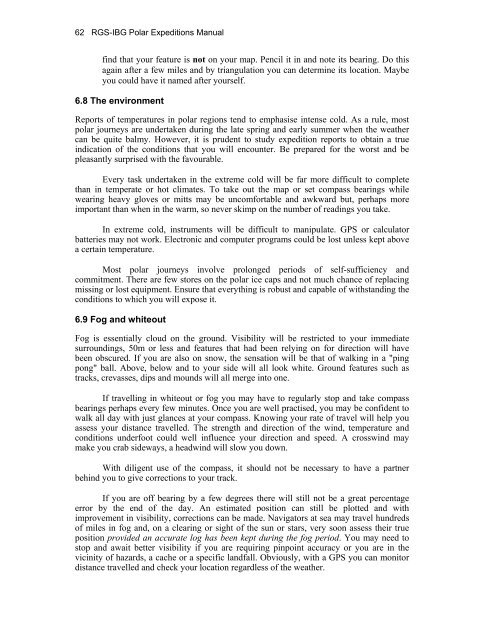Edited by Rachel Duncan 4th Edition ISBN 0-907649-91-2 London ...
Edited by Rachel Duncan 4th Edition ISBN 0-907649-91-2 London ...
Edited by Rachel Duncan 4th Edition ISBN 0-907649-91-2 London ...
Create successful ePaper yourself
Turn your PDF publications into a flip-book with our unique Google optimized e-Paper software.
62 RGS-IBG Polar Expeditions Manual<br />
find that your feature is not on your map. Pencil it in and note its bearing. Do this<br />
again after a few miles and <strong>by</strong> triangulation you can determine its location. Maybe<br />
you could have it named after yourself.<br />
6.8 The environment<br />
Reports of temperatures in polar regions tend to emphasise intense cold. As a rule, most<br />
polar journeys are undertaken during the late spring and early summer when the weather<br />
can be quite balmy. However, it is prudent to study expedition reports to obtain a true<br />
indication of the conditions that you will encounter. Be prepared for the worst and be<br />
pleasantly surprised with the favourable.<br />
Every task undertaken in the extreme cold will be far more difficult to complete<br />
than in temperate or hot climates. To take out the map or set compass bearings while<br />
wearing heavy gloves or mitts may be uncomfortable and awkward but, perhaps more<br />
important than when in the warm, so never skimp on the number of readings you take.<br />
In extreme cold, instruments will be difficult to manipulate. GPS or calculator<br />
batteries may not work. Electronic and computer programs could be lost unless kept above<br />
a certain temperature.<br />
Most polar journeys involve prolonged periods of self-sufficiency and<br />
commitment. There are few stores on the polar ice caps and not much chance of replacing<br />
missing or lost equipment. Ensure that everything is robust and capable of withstanding the<br />
conditions to which you will expose it.<br />
6.9 Fog and whiteout<br />
Fog is essentially cloud on the ground. Visibility will be restricted to your immediate<br />
surroundings, 50m or less and features that had been relying on for direction will have<br />
been obscured. If you are also on snow, the sensation will be that of walking in a "ping<br />
pong" ball. Above, below and to your side will all look white. Ground features such as<br />
tracks, crevasses, dips and mounds will all merge into one.<br />
If travelling in whiteout or fog you may have to regularly stop and take compass<br />
bearings perhaps every few minutes. Once you are well practised, you may be confident to<br />
walk all day with just glances at your compass. Knowing your rate of travel will help you<br />
assess your distance travelled. The strength and direction of the wind, temperature and<br />
conditions underfoot could well influence your direction and speed. A crosswind may<br />
make you crab sideways, a headwind will slow you down.<br />
With diligent use of the compass, it should not be necessary to have a partner<br />
behind you to give corrections to your track.<br />
If you are off bearing <strong>by</strong> a few degrees there will still not be a great percentage<br />
error <strong>by</strong> the end of the day. An estimated position can still be plotted and with<br />
improvement in visibility, corrections can be made. Navigators at sea may travel hundreds<br />
of miles in fog and, on a clearing or sight of the sun or stars, very soon assess their true<br />
position provided an accurate log has been kept during the fog period. You may need to<br />
stop and await better visibility if you are requiring pinpoint accuracy or you are in the<br />
vicinity of hazards, a cache or a specific landfall. Obviously, with a GPS you can monitor<br />
distance travelled and check your location regardless of the weather.

















